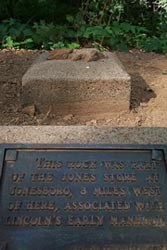
NPS Photo The Trail of Twelve Stones connects the homesite of Abraham Lincoln's youth with the pioneer cemetery where his mother, Nancy Hanks Lincoln, is buried. The stones were obtained and placed by the Indiana Lincoln Union in 1933. Beginning just east of the Cabin Site Memorial on the Thomas Lincoln Farm, the stones are arranged in chronological order at irregular intervals along the trail. They commemorate major events in Lincoln's life and career. At each site along the trail, a small bronze tablet briefly explains the events associated with the memorial stone. The first stone originates from the traditional birthplace of Abraham Lincoln on the Sinking Spring Farm near Hodgenville, Kentucky, where he was born on Sunday, February 12, 1809. The second stone is the original Indiana cabin site marker that was donated by the citizens of Spencer County. This stone memorializes young Abraham's 14 boyhood years in Indiana. The third stone comes from the foundation of the William Jones store where the teenaged Lincoln worked as a clerk. The store was located three miles west of here and seven tenths of a mile west of Gentryville, Indiana. The fourth stone was part of the foundation of the Vincennes Sun Newspaper in Vincennes, Indiana, where Lincoln first viewed a printing press. The Lincoln family stopped in Vincennes during their move to Illinois in early March 1830. The fifth stone was a gift of the Illinois Department of Conservation from the foundation of the Berry-Lincoln store in New Salem, Illinois. In 1832, Lincoln bought a half-interest in the store and went into business with William Berry. The sixth stone is comprised of four bricks set in concrete. The bricks were brought from Lexington, Kentucky, the home of Mary Todd, wife of Abraham Lincoln. The mayor of Lexington donated the bricks. The seventh stone is from the White House in Washington, D.C. Abraham Lincoln lived there as president from March 4, 1861 to April 15, 1865. The eighth stone is from the Anderson Cottage at the National Soldiers Home in Washington, D.C. where Lincoln wrote the Emancipation Proclamation in September of 1862. The ninth stone came from the Civil War battlefield at Gettysburg, Pennsylvania where Lincoln delivered his famous address on November 19, 1863. This stone was a gift of the War Department. The tenth stone was part of the Old Capitol building in Washington, D.C. There, Lincoln made his second inaugural address on March 4, 1865. This well-known Lincoln speech included these words, "to do all which may achieve and cherish a just and lasting peace among ourselves, and with all nations." The eleventh stone is a piece of an original porch pillar from the Peterson House in Washington, D.C., the house where Lincoln died. General U.S. Grant III donated the column section when he was in charge of the house. The pillar was cut from Seneca Creek sandstone quarried near Washington, D.C. The twelfth stone is a block of granite, excess to the remodeling of the Lincoln Tomb at Springfield, Illinois. It is called the Culver Stone in honor of its donor, J.S. Culver, the contractor for the remodeling job, who had it carved as a memorial to Lincoln's mother, Nancy Hanks Lincoln. The Culver Stone was originally placed in front of the Nancy Hanks Lincoln headstone in the cemetery here. Dedicated on October 1, 1902, the stone remained there until 1933 when it was moved to its present position to mark the end of the Trail of Twelve Stones. |
Last updated: July 27, 2021
